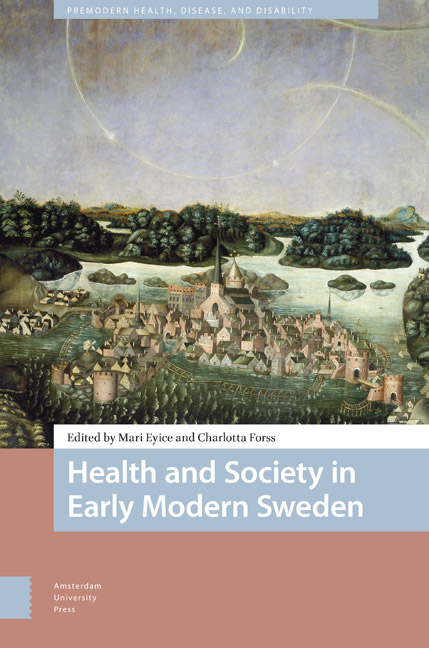Book contents
- Frontmatter
- Contents
- List of Tables and Figures
- Acknowledgements
- 1 Meanings of Health in Early Modern Sweden
- 2 Illness as Incapacity to Work in Early Modern Sweden
- 3 The Body in the Bathhouse: Health and Bathing in Early Modern Sweden
- 4 ‘Somewhat Heated, Quick and Lively’ : Humoral Explanations of the Learning Difficulties of Charles XI of Sweden (1655–1697)
- 5 Health in Body and Soul in a Female Birgittine Convent 1516–1522
- 6 Curing Madness and Mental Disturbances : Religious Healing Activities in Early Modern Swedish Local Communities
- 7 Not Quacks but Close : Reappraising the Role of Physicians on the Eighteenth-Century Medical Market
- 8 Gender, Health, and Hair in Sweden, 1740–1840
- 9 Gender Norms and Early Modern Healthcare : Barber-Surgeons in Sweden c. 1600–1900
- Epilogue : Epistemologies of Body and Soul: Considering the Early Modern and (Late) Modern History of Health
- Index
6 - Curing Madness and Mental Disturbances : Religious Healing Activities in Early Modern Swedish Local Communities
Published online by Cambridge University Press: 16 April 2024
- Frontmatter
- Contents
- List of Tables and Figures
- Acknowledgements
- 1 Meanings of Health in Early Modern Sweden
- 2 Illness as Incapacity to Work in Early Modern Sweden
- 3 The Body in the Bathhouse: Health and Bathing in Early Modern Sweden
- 4 ‘Somewhat Heated, Quick and Lively’ : Humoral Explanations of the Learning Difficulties of Charles XI of Sweden (1655–1697)
- 5 Health in Body and Soul in a Female Birgittine Convent 1516–1522
- 6 Curing Madness and Mental Disturbances : Religious Healing Activities in Early Modern Swedish Local Communities
- 7 Not Quacks but Close : Reappraising the Role of Physicians on the Eighteenth-Century Medical Market
- 8 Gender, Health, and Hair in Sweden, 1740–1840
- 9 Gender Norms and Early Modern Healthcare : Barber-Surgeons in Sweden c. 1600–1900
- Epilogue : Epistemologies of Body and Soul: Considering the Early Modern and (Late) Modern History of Health
- Index
Summary
Abstract
The chapter discusses how religion and religious practices were used in healing madness in seventeenth- and early eighteenth-century Sweden. According to holistic ideas on health, true faith demonstrated via religious practice was vital both for recovering from illnesses and for upholding and improving one's health. The afflicted themselves, and their kin, as well as parish communities and clergy sought alleviation from mental disturbances through prayer, hymn singing and other religious rituals. These spiritual healing practices that were in line with the era's orthodox Lutheranism were encouraged by medical and church authorities. Local clergy assisted in this process, by counselling, visitations, and organising communal prayers in churches. Families and other local communities could also participate in the healing process.
Keywords: history of madness, history of insanity, religious healing, lived religion, mental health care, early modern Sweden
Introduction
The chapter examines mental health care in early modern Swedish local communities, and in particular the religious activities that were aimed at finding cures for or alleviating madness and mental disturbances. After briefly providing background about the role of religion in medicine and healing in the early modern culture, the chapter discusses the spiritual healing practices carried out at the local level, in particular by local clergy and the rural lay communities, in early modern Sweden (including Finland) during the seventeenth and early eighteenth centuries (c. 1600s–1730s). This time frame covers the era when the Swedish Realm was at its largest and the period of Lutheran Orthodoxy. This period is characterised as a time when religion was an integral part of medicine. Moreover, this is a time when many new natural-scientific and medical ideas, and the professionalisation and ‘secularisation’ of medicine, were only slowly contributing to the healing practices in the northern periphery of Europe.
A court record from southwestern Finland from 1700 offers a starting point and a good example about the ways religion, and churchmen, were involved in healthcare. Around the year 1680 Brita, a soldier's widow in her late fifties, lost her mind, or started suffering from an undetermined ‘weakness in the head’ (Swe. hufwud swaghet).
- Type
- Chapter
- Information
- Health and Society in Early Modern Sweden , pp. 125 - 150Publisher: Amsterdam University PressPrint publication year: 2024



